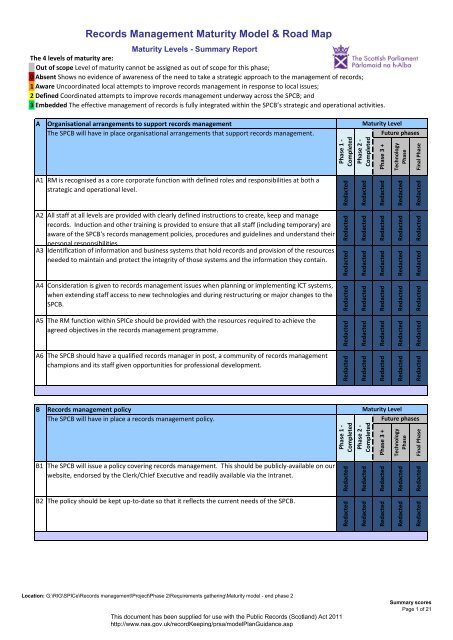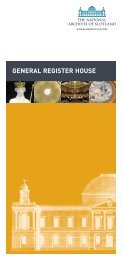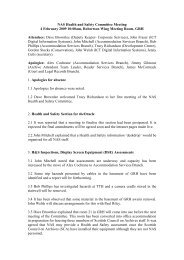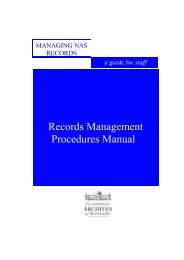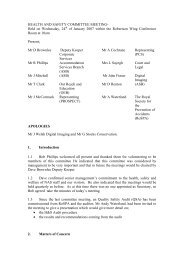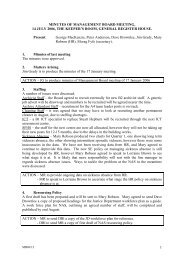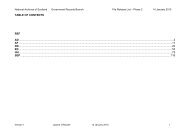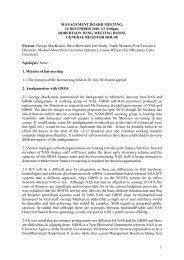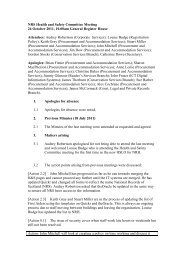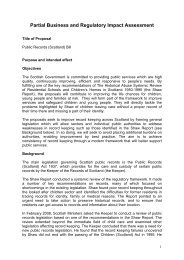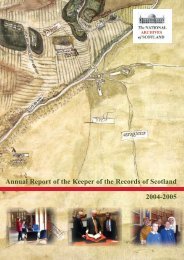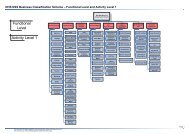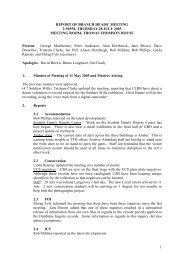SPCB records management maturity model - National Archives of ...
SPCB records management maturity model - National Archives of ...
SPCB records management maturity model - National Archives of ...
You also want an ePaper? Increase the reach of your titles
YUMPU automatically turns print PDFs into web optimized ePapers that Google loves.
Phase 1 -CompletedPhase 1 -CompletedRedactedRedactedRedactedRedactedRedactedRedactedRedactedRedactedPhase 2 -CompletedPhase 2 -CompletedRedactedRedactedRedactedRedactedRedactedRedactedRedactedRedactedPhase 3 +RedactedRedactedRedactedRedactedRedactedRedactedPhase 3 +RedactedRedactedTechnologyPhaseTechnologyPhaseRedactedRedactedRedactedRedactedRedactedRedactedRedactedRedactedRedactedRedactedRedactedRedactedRedactedRedactedRedactedRedactedFinal PhaseFinal PhaseRecords Management Maturity Model & Road MapMaturity Levels - Summary ReportThe 4 levels <strong>of</strong> <strong>maturity</strong> are:Out <strong>of</strong> scope Level <strong>of</strong> <strong>maturity</strong> cannot be assigned as out <strong>of</strong> scope for this phase;0 Absent Shows no evidence <strong>of</strong> awareness <strong>of</strong> the need to take a strategic approach to the <strong>management</strong> <strong>of</strong> <strong>records</strong>;1 Aware Uncoordinated local attempts to improve <strong>records</strong> <strong>management</strong> in response to local issues;2 Defined Coordinated attempts to improve <strong>records</strong> <strong>management</strong> underway across the <strong>SPCB</strong>; and3 Embedded The effective <strong>management</strong> <strong>of</strong> <strong>records</strong> is fully integrated within the <strong>SPCB</strong>’s strategic and operational activities.EStorage and maintenance <strong>of</strong> <strong>records</strong>The <strong>SPCB</strong> will know what <strong>records</strong> it holds and where they are, and should ensure that they remainusable for as long as they are required.Maturity LevelFuture phasesE1 The <strong>SPCB</strong> will gather and maintain data on the <strong>records</strong> and information assets its holds and willconsider publishing the details <strong>of</strong> types <strong>of</strong> record it holds to help members <strong>of</strong> the public planningto make a request for information under the Freedom <strong>of</strong> Information (Scotland) Act.E2 Storage facilities for <strong>records</strong> should provide protection to the level required by the nature,contents and value <strong>of</strong> the information in them and be appropriate for their level <strong>of</strong> use.E3 The whereabouts <strong>of</strong> <strong>records</strong> should be known at all times and movement <strong>of</strong> files and other physical<strong>records</strong> between storage areas and <strong>of</strong>fice areas should be logged.E4 Records should remain usable for as long as they are required. The <strong>SPCB</strong> should put in place astrategy for the continued maintenance <strong>of</strong> <strong>records</strong> stored in digital systems and regularly inspectvulnerable paper files (e.g. early photocopies).E5 Business continuity plans should identify and safeguard <strong>records</strong> considered vital to theorganisation and backup copies <strong>of</strong> <strong>records</strong> in digital systems should be kept and stored securely ina separate location.E6 Metadata for <strong>records</strong> in any format should be kept in such a way that it remains reliable andaccessible for as long as it is required, which will be at least for the life <strong>of</strong> the <strong>records</strong>.FSecurity & accessThe <strong>SPCB</strong> will ensure that <strong>records</strong> are stored securely and that access to them is controlled.Maturity LevelFuture phasesF1 The <strong>SPCB</strong> will ensure that their storage arrangements, handling procedures and arrangements fortransmission <strong>of</strong> <strong>records</strong> (particularly outside <strong>of</strong> the <strong>SPCB</strong>'s premises) reflect accepted standardsand good practice in information security.F2 Access restrictions should be applied when necessary to protect the information concerned andshould be kept up to date with external access being provided in accordance with relevantlegislation.Location: G:\RIG\SPICe\Records <strong>management</strong>\Project\Phase 2\Requirements gathering\Maturity <strong>model</strong> - end phase 2Summary scoresPage 3 <strong>of</strong> 21
Phase 1 -CompletedRedactedRedactedRedactedRedactedRedactedRedactedRedactedPhase 2 -CompletedRedactedRedactedRedactedRedactedRedactedRedactedRedactedPhase 3 +RedactedRedactedRedactedRedactedRedactedRedactedRedactedTechnologyPhaseRedactedRedactedRedactedRedactedRedactedRedactedRedactedRedactedRedactedRedactedRedactedRedactedRedactedRedactedFinal PhaseRecords Management Maturity Model & Road MapMaturity Levels - Summary ReportThe 4 levels <strong>of</strong> <strong>maturity</strong> are:Out <strong>of</strong> scope Level <strong>of</strong> <strong>maturity</strong> cannot be assigned as out <strong>of</strong> scope for this phase;0 Absent Shows no evidence <strong>of</strong> awareness <strong>of</strong> the need to take a strategic approach to the <strong>management</strong> <strong>of</strong> <strong>records</strong>;1 Aware Uncoordinated local attempts to improve <strong>records</strong> <strong>management</strong> in response to local issues;2 Defined Coordinated attempts to improve <strong>records</strong> <strong>management</strong> underway across the <strong>SPCB</strong>; and3 Embedded The effective <strong>management</strong> <strong>of</strong> <strong>records</strong> is fully integrated within the <strong>SPCB</strong>’s strategic and operational activities.GDisposal <strong>of</strong> <strong>records</strong>The <strong>SPCB</strong> will define how long it needs to keep particular <strong>records</strong>, should dispose <strong>of</strong> them whenthey are no longer needed and should be able to explain why <strong>records</strong> are no longer held.Maturity LevelFuture phasesG1 Records should not be kept after they have ceased to be <strong>of</strong> use to the <strong>SPCB</strong> unless they are knownto be the subject <strong>of</strong> litigation or a request for information; or they have long-term value forhistorical or other research purposes.G2 Disposal <strong>of</strong> <strong>records</strong> should be undertaken only in accordance with clearly established policiesincuding: a) An overall policy, stating in broad terms the types <strong>of</strong> <strong>records</strong> likely to be selected forpermanent preservation; and b) retention schedules which identify and describe <strong>records</strong> to whicha re-defined disposal action can be applied.G3 Retention schedules should contain sufficient details about the <strong>records</strong> to enable the <strong>records</strong> to beeasily identified and the disposal action applied to them on a routine and timely basis. Retentionschedules should be kept up to date. Retention schedules and disposal decisions should beimplemented by properly authorised staff and should take account <strong>of</strong> variations caused by, forexample, outstanding requests for information or litigation.G4 If any <strong>records</strong> are not included in retention schedules, arrangements should be made to reviewthem and decide whether they can be destroyed or should be selected for permanentpreservation.G5 All copies <strong>of</strong> <strong>records</strong> scheduled for destruction should be destroyed in as secure a manner asrequired by the level <strong>of</strong> confidentiality or security markings they bear, regardless <strong>of</strong> whetherdestruction is carried out ‘in house’ or by external contractor.G6 Details <strong>of</strong> destruction <strong>of</strong> <strong>records</strong> should be kept, either as part <strong>of</strong> the audit trail metadata orseparately.G7 Records selected for permanent preservation and no longer required by the <strong>SPCB</strong> will betransferred to the <strong>National</strong> <strong>Archives</strong> <strong>of</strong> Scotland (NAS).Location: G:\RIG\SPICe\Records <strong>management</strong>\Project\Phase 2\Requirements gathering\Maturity <strong>model</strong> - end phase 2Summary scoresPage 4 <strong>of</strong> 21
ARecords Management Maturity Model Road MapEnd Phase 2Organisational arrangements to support <strong>records</strong> <strong>management</strong>The <strong>SPCB</strong> will have in place organisational arrangements that support <strong>records</strong> <strong>management</strong>.Statement A1RM is recognised as a core corporate function with defined roles and responsibilities at both a strategic and operational level.Level 0 Responsibility for RM is not defined or allocated within the <strong>SPCB</strong> and is not considered as part <strong>of</strong> its strategic planning processes.Level 1 Various departmental staff given nominal operational responsibility for addressing specific local RM-related issues alongside theirexisting role.Level 2 Departmental staff operate in a coordinated fashion receiving instruction from the core corporate RM function which in turnreports to senior responsible <strong>of</strong>ficers.Level 3 RM-related issues are viewed as an ongoing strategic priority for the <strong>SPCB</strong> and are routinely considered during strategic andoperational decision making. The core RM function work with a network <strong>of</strong> local co-ordinators to work towards agreed strategicobjectives. Members <strong>of</strong> <strong>management</strong> at all levels are aware that they are directly responsible for ensuring recordkeepingstandards within their areas.Notes:Score: R e d a c t e dStatement A2All staff at all levels are provided with clearly defined instructions to create, keep and manage <strong>records</strong>. Induction and other training isprovided to ensure that all staff (including temporary) are aware <strong>of</strong> the <strong>SPCB</strong>'s <strong>records</strong> <strong>management</strong> policies, procedures andguidelines and understand their personal responsibilities.Level 0 No training or guidance provided on RM issues with the <strong>SPCB</strong> content to leave individuals to make up their own workingpractice.Level 1 Some training is given to new starters in some departments based on agreed local practice.Level 2 Training is provided on request to local teams/staff. Limited mention is made <strong>of</strong> RM policies and procedures as part <strong>of</strong> standardstaff induction.Level 3 A detailed session(s) on RM policies and procedures is provided to all new staff shortly after joining the <strong>SPCB</strong> as part <strong>of</strong> theinduction programme. Training on a range <strong>of</strong> RM issues is also available at various levels <strong>of</strong> expertise on demand to all staff aspart <strong>of</strong> the regular staff development programme.Notes:Score: R e d a c t e dStatement A3Identification <strong>of</strong> information and business systems that hold <strong>records</strong> and provision <strong>of</strong> the resources needed to maintain and protectthe integrity <strong>of</strong> those systems and the information they contain.Level 0 A proliferation <strong>of</strong> local systems exist whose contents and whereabouts are unknown to all but their immediate users.Level 1 Unco-ordinated attempts to rationalise the number and remit <strong>of</strong> record keeping systems within certain departments foroperational reasons.Level 2 A systematic audit undertaken across the <strong>SPCB</strong> to record the existence, purpose, contents and <strong>management</strong> <strong>of</strong> all systemsholding <strong>records</strong> and information.Level 3 An authoritative database <strong>of</strong> recordkeeping systems and their ‘owners’ is centrally compiled and actively maintained.Procedures exist to ensure this database is kept up to date. The database is used to help prioritise and plan routine maintenanceand to allocate resources accordingly. An authoritative database <strong>of</strong> recordkeeping systems and their ‘owners’ is centrallycompiled and actively maintained. Procedures exist to ensure this database is kept up to date. The database is used to helpprioritise and plan routine maintenance and to allocate resources accordingly.Notes: No <strong>records</strong> <strong>management</strong> system is in place.Score: R e d a c t e dLocation: G:\RIG\SPICe\Records <strong>management</strong>\Project\Phase 2\Requirements gathering\Maturity <strong>model</strong> - end phase 2End phase 2 scoresPage 6 <strong>of</strong> 21
ARecords Management Maturity Model Road MapEnd Phase 2Organisational arrangements to support <strong>records</strong> <strong>management</strong>The <strong>SPCB</strong> will have in place organisational arrangements that support <strong>records</strong> <strong>management</strong>.Statement A4Consideration is given to <strong>records</strong> <strong>management</strong> issues when planning or implementing ICT systems, when extending staff access to newtechnologies and during restructuring or major changes to the <strong>SPCB</strong>.Level 0 Changes to systems or processes happen in a haphazard manner with no consideration <strong>of</strong> their record <strong>management</strong> implications.Level 1 Some consideration <strong>of</strong> the likely impact <strong>of</strong> change on local record and information use and ad hoc attempts to plan localresponses (mainly reactive in nature). For example considering measures to address the reduction in record storage capacityfollowing a move to new <strong>of</strong>fice accommodation.Level 2 Attempts made to predict and prepare for the RM related implications <strong>of</strong> process, system or organisational change in a joined-upfashion across the <strong>SPCB</strong> For example, working groups established in advance to consider the implications for the <strong>SPCB</strong>'sinformation assets following a proposed merger.Level 3 RM representation on major relevant project planning and senior <strong>management</strong> advisory groups. All other such groups areformally required to actively consider and consult on <strong>records</strong> <strong>management</strong> issues as and when they arise. Decisions regardingsystem choice or other proposed changes are actively influenced by consideration <strong>of</strong> RM issues. For example not selecting anotherwise preferred information system due to deficiencies in its <strong>records</strong> <strong>management</strong> capabilities.Notes:Score: R e d a c t e dStatement A5The RM function within SPICe should be provided with the resources required to achieve the agreed objectives in the <strong>records</strong><strong>management</strong> programme.Level 0 No funds, staff or facilities devoted to the RM programme.Level 1 Small ‘one <strong>of</strong>f’ sources <strong>of</strong> funding found on an ad hoc basis (for example when a budget under spend is identified towards theend <strong>of</strong> the financial year) to enable small scale local improvements.Level 2 An appropriate annual budget is allocated for funding the <strong>SPCB</strong>'s RM programme which covers both ongoing ‘core activity’ andadditional special projects.Level 3 Records <strong>management</strong> is given its own budget code within the <strong>SPCB</strong> and provided with appropriate funds to be able to meet itsagreed strategic and operational objectives. Staff working within the RM function are encouraged to undertake furtherpr<strong>of</strong>essional development and/or qualifications and to apply this learning within the <strong>SPCB</strong>.Notes:Score: R e d a c t e dStatement A6The <strong>SPCB</strong> should have a qualified <strong>records</strong> manager in post, a community <strong>of</strong> <strong>records</strong> <strong>management</strong> champions and its staff givenopportunities for pr<strong>of</strong>essional development.Level 0 No <strong>records</strong> manager or champion community is in place.Level 1 Records <strong>management</strong> is recognised as a function but has not been assigned a specific role with responsibility for <strong>records</strong><strong>management</strong>.Level 2 The <strong>SPCB</strong> has a dedicated <strong>records</strong> manager post with responsibility for <strong>records</strong> <strong>management</strong>.Level 3 The <strong>SPCB</strong> has a <strong>records</strong> manager in post and a community <strong>of</strong> <strong>records</strong> <strong>management</strong> champions in place. Pr<strong>of</strong>essionaldeveleopment is available and encouraged.Notes:Score: R e d a c t e dLocation: G:\RIG\SPICe\Records <strong>management</strong>\Project\Phase 2\Requirements gathering\Maturity <strong>model</strong> - end phase 2End phase 2 scoresPage 7 <strong>of</strong> 21
BRecords Management Maturity Model Road MapEnd Phase 2Records <strong>management</strong> policyThe <strong>SPCB</strong> will have in place a <strong>records</strong> <strong>management</strong> policy.Statement B1The <strong>SPCB</strong> will issue a policy covering <strong>records</strong> <strong>management</strong>. This should be publicly-available on our website, endorsed by theClerk/Chief Executive and readily available via the intranet.Level 0 No appetite for developing an RM policy, or including elements <strong>of</strong> it within other relevant policies is evident within the <strong>SPCB</strong>, thesubject is not on senior <strong>management</strong>’s ‘radar’.Level 1 Individual departments have established local policies covering aspects <strong>of</strong> RM in response to local need and reflecting localcircumstance (not generally publicly available).Level 2 Moves afoot to draft and agree the required elements <strong>of</strong> an RM policy for the entire <strong>SPCB</strong>. Discussions include input from acrossthe <strong>SPCB</strong> at a managerial level as well as pr<strong>of</strong>essional RM engagement.Level 3 The required elements <strong>of</strong> the <strong>SPCB</strong>'s RM policy has been endorsed by senior <strong>management</strong> and are widely available, either as astand alone document or as part <strong>of</strong> other relevant policies.The policy(s) is also made publicly available to any interested parties via the Parliament's website.Notes:Score: R e d a c t e dStatement B2The policy should be kept up-to-date so that it reflects the current needs <strong>of</strong> the <strong>SPCB</strong>.Level 0 No policy(s) to update.Level 1 Updates tend to be unscheduled and sporadic and only occur when a particular event brings the issue to light or following theenthusiasm <strong>of</strong> an individual member <strong>of</strong> staff.Level 2 The policy(s) is included amongst many others in periodic wide scale policy review initiatives.Level 3 A review date is included within the new policy(s) to trigger a future review <strong>of</strong> the policy(s) after a stated period <strong>of</strong> time; orfollowing a major organisational or technological change affecting its contents. A post-holder is identified as being responsiblefor enacting the review and any subsequent amendments.Notes:Score: R e d a c t e dLocation: G:\RIG\SPICe\Records <strong>management</strong>\Project\Phase 2\Requirements gathering\Maturity <strong>model</strong> - end phase 2End phase 2 scoresPage 8 <strong>of</strong> 21
CRecords Management Maturity Model Road MapEnd Phase 2Keeping <strong>records</strong> to meet corporate requirementsThe <strong>SPCB</strong> will ensure it keeps the <strong>records</strong> it will need for business, regulatory, legal and accountability purposes.Statement C1The <strong>SPCB</strong> will decide – and staff must know – what <strong>records</strong> need to be created and kept to protect the interests <strong>of</strong> the organisationand its stakeholders.Level 0 No set rules exist. The identification and capture <strong>of</strong> business <strong>records</strong> is sporadic and down to the judgement and best efforts <strong>of</strong>individuals.Level 1 Local rules are defined within some departments covering capture <strong>of</strong> the most important record series and definingresponsibility for their capture. Such rules are uncoordinated and may be contradictory between local areas.Level 2 Concerted efforts are underway to define business rules for identifying, capturing and managing <strong>records</strong> across the <strong>SPCB</strong>.Level 3 Business rules are defined, agreed and enacted for all record series created across the <strong>SPCB</strong>. As a result the ‘master copy’ <strong>of</strong>each record has been identified and a responsible owner assigned. Procedures are in place to ensure <strong>records</strong> are managedaccording to these rules as part <strong>of</strong> ‘business as usual’. For example the routine capture, weeding and central storage <strong>of</strong> a predefinedset <strong>of</strong> project <strong>records</strong> as part or the project closure process. Attempts to tie the responsibility for creating <strong>records</strong> tospecific posts underway.Notes:Score: R e d a c t e dStatement C2Managers <strong>of</strong> <strong>of</strong>fices, programmes and projects should take responsibility for ensuring that the agreed <strong>records</strong> <strong>of</strong> the <strong>of</strong>fice, programmeor project's work are kept and are available for corporate use.Level 0 Managers reluctant (or refuse) to acknowledge responsibility; either because <strong>of</strong> a lack <strong>of</strong> understanding <strong>of</strong> the issues and/or amistaken belief that any such responsibilities lie elsewhere.Level 1 Some managers aware <strong>of</strong> their responsibilities in this regard and have concerns regarding potential consequences but lack theknowledge and/or time to devise appropriate local strategies.Level 2 Responsibility for ensuring appropriate RM controls is formally added to the job descriptions/list <strong>of</strong> responsibilities for all levels<strong>of</strong> junior, middle and senior <strong>management</strong> across all areas <strong>of</strong> the <strong>SPCB</strong>.Level 3 Managers have a sound grasp <strong>of</strong> RM considerations and their particular relevance within their own specific area <strong>of</strong> control.Managers proactively consider the implications <strong>of</strong> change (e.g. the introduction <strong>of</strong> new technology) on their areas ability to fulfiltheir required RM responsibilities and seek to initiate appropriate local strategies in response (e.g. issuing guidance definingwhen the use <strong>of</strong> Instant Messenger is or isn’t appropriate for conducting operational business).Notes:Score: R e d a c t e dLocation: G:\RIG\SPICe\Records <strong>management</strong>\Project\Phase 2\Requirements gathering\Maturity <strong>model</strong> - end phase 2End phase 2 scoresPage 9 <strong>of</strong> 21
CRecords Management Maturity Model Road MapEnd Phase 2Keeping <strong>records</strong> to meet corporate requirementsThe <strong>SPCB</strong> will ensure it keeps the <strong>records</strong> it will need for business, regulatory, legal and accountability purposes.Statement C3The <strong>SPCB</strong> will ensure that those <strong>records</strong> identified as being required to protect the interests <strong>of</strong> the organisation and its stakeholdersare captured and kept appropriately to ensure they meet appropriate standards <strong>of</strong> usability, reliability, integrity and authority.Level 0 No minimum ‘quality standards’ regarding the <strong>records</strong> usability, reliability, integrity or authority have been determined andconsequently no measures are in place to ensure they are met.Level 1 Procedures and business rules exist within some departments but relate only to a limited number <strong>of</strong> specific <strong>records</strong> <strong>of</strong> highimportance (e.g. finance <strong>records</strong>).Level 2 Business rules exist for all record series across the <strong>SPCB</strong>. These include attempts to identify the ‘single source <strong>of</strong> truth’, whoowns it and how it should be managed throughout its lifecycle. Work is also underway to achieve a degree <strong>of</strong> standardisation inareas such as file naming and record titling.Level 3 Where possible agreed business rules aimed at ensuring the quality <strong>of</strong> <strong>records</strong> are applied ‘automatically’ (e.g. record keepingsystems which automatically capture copies <strong>of</strong> <strong>records</strong> after pre-defined events have taken place). All staff are provided withinstruction regarding general responsibilities for record capture as part <strong>of</strong> regular IT or operational training. Business rules andguidance ensures that any remaining ephemeral information is routinely discarded after an appropriate period.Notes:Score: R e d a c t e dLocation: G:\RIG\SPICe\Records <strong>management</strong>\Project\Phase 2\Requirements gathering\Maturity <strong>model</strong> - end phase 2End phase 2 scoresPage 10 <strong>of</strong> 21
DRecords Management Maturity Model Road MapEnd Phase 2Records systemsThe <strong>SPCB</strong> will keep <strong>records</strong> in systems that enable <strong>records</strong> to be stored and retrieved as necessary.Statement D1Records systems should be designed to meet the <strong>SPCB</strong>'s operational needs and using them should be an integral part <strong>of</strong> businessoperations and processes. They should be easy to understand and use, enable easy retrieval <strong>of</strong> information and set up in a way thatenables routine RM processes to take place. Records systems should enable the context <strong>of</strong> each record and its relationship to other<strong>records</strong> to be understood (e.g. through classification in a file plan and/or through the application <strong>of</strong> appropriate metadata) and forgroups <strong>of</strong> like <strong>records</strong> to be managed together. Record systems should produce an audit trail recording all actions performed on itscontents.Level 0 Systems do not have the capacity to manage information as <strong>records</strong>. Systems holding <strong>records</strong> are (instead) either chosen fortheir operational functionality or on other grounds (e.g. cost, ubiquity etc). As a result the <strong>records</strong> they contain are poorly andinconsistently managed with little chance <strong>of</strong> improvement within the constraints <strong>of</strong> the existing systems.Level 1 Local attempts to reconfigure existing systems or discover ways <strong>of</strong> better using existing systems to improve the <strong>management</strong> <strong>of</strong><strong>records</strong>. For example improving the naming <strong>of</strong> files within a shared drive or devising an agreed metadata schema. Thesesystems tend to be ‘stand alone’ applications, accessed and used by a limited number <strong>of</strong> staff and not integrated into regularbusiness processes.Level 2 Work is underway to define <strong>SPCB</strong>-wide standards to govern the arrangement, description and capture <strong>of</strong> <strong>records</strong>, for example byestablishing a business classification scheme and file plan. Plans are underway to implement <strong>SPCB</strong>-wide systems based on thesestandards and for them to be accessible by all those with a need to use them.Level 3 The <strong>SPCB</strong> has an integrated suite <strong>of</strong> record systems, all subject to the same <strong>management</strong> controls and all based on the same,shared corporate standards. These systems include both structured and unstructured data, are accessible by all those whoneed to use them and are fully integrated into the business processes they support. Any proposed new systems mustdemonstrate how they will integrate into this suite before being considered.Notes:Score: R e d a c t e dStatement D2Record systems should provide secure storage to the level <strong>of</strong> protection required by the nature, contents and value <strong>of</strong> the informationin them and should protect <strong>records</strong> in digital systems from accidental or unauthorised alteration, copying, movement or deletion.Level 0 Systems have no or just simple, single-level authentication only, with no multi-level access rights. Once within the system eachuser can see and do as they wish.Level 1 Local departments have identified what they consider to be the most sensitive/confidential <strong>records</strong> and implemented the bestlevel <strong>of</strong> protection that current systems can provide. Levels <strong>of</strong> protection and control vary dependent on the attitudes <strong>of</strong>individual staff members and the functionality <strong>of</strong> the systems in question.Level 2 A concerted effort is underway to understand the nature <strong>of</strong> the <strong>records</strong> held and the level <strong>of</strong> security, access and control theymust be subject to. Any systems not considered to be <strong>of</strong>fering an appropriate level <strong>of</strong> protection are flagged for rapidmodification/replacement.Level 3 Access to all record systems is closely controlled, with users only having access to the <strong>records</strong> they need as part <strong>of</strong> their role andwith all user behaviour within systems monitored and security breaches flagged to the administrator. Non-reversible actions(e.g. record deletion) can only be performed by a small number <strong>of</strong> administrators and are impossible to undertake accidently.Notes: Systems used to manage information as <strong>records</strong> have limited access rights and control. Users can see and do as they wish.Score: R e d a c t e dLocation: G:\RIG\SPICe\Records <strong>management</strong>\Project\Phase 2\Requirements gathering\Maturity <strong>model</strong> - end phase 2End phase 2 scoresPage 11 <strong>of</strong> 21
DRecords Management Maturity Model Road MapEnd Phase 2Records systemsThe <strong>SPCB</strong> will keep <strong>records</strong> in systems that enable <strong>records</strong> to be stored and retrieved as necessary.Statement D3Records systems should be documented to facilitate staff training, maintenance <strong>of</strong> the system and its reconstruction in the event <strong>of</strong> anemergency.Level 0 Documentation relating to <strong>records</strong> systems is incomplete and difficult/impossible to locate.Level 1 Some local record systems have a limited amount <strong>of</strong> ‘<strong>of</strong>ficial’ documentation, but <strong>of</strong>ten not complete, up to date or centrallyaccessible. New users are left to ‘pick up’ the system themselves after limited, informal training.Level 2 All documentation on existing systems located and brought under central <strong>management</strong>.Handbooks, FAQs and help sheets are made available to relevant staff.Level 3 All record systems fully documented with relevant documentation managed centrally and copies <strong>of</strong> key system descriptionsstored separately alongside other disaster recovery <strong>records</strong>. A range <strong>of</strong> audience-specific guidance is created and regularlyupdated for administrators and users to consult.Notes:Score: R e d a c t e dStatement D4Record systems should enable the closure <strong>of</strong> folders, files and similar <strong>records</strong> at an appropriate time according to the specific natureand function <strong>of</strong> the <strong>records</strong> in question and should be supported by processes designed to identify and act upon such triggers forclosure.Level 0 No facility to ‘close’ <strong>records</strong> within record systems which consequently remain ‘live’ until removed from the system (or thewithdrawal <strong>of</strong> the system).Level 1 Closure <strong>of</strong> <strong>records</strong> within local systems requires significant manual intervention and is reliant on staff remembering to do it – ifand when informed that the trigger-event has occurred.Level 2 All <strong>records</strong> requiring event/time based closure have been identified. Trigger events/periods are mapped for all <strong>records</strong> and havebeen agreed but applying them is still a ‘manual’ and sporadic process.Level 3 All record systems can automatically close <strong>records</strong> based on agreed, pre-defined triggers. There are clear lines <strong>of</strong>communication to inform all relevant systems when a closure trigger has occurred and, where possible, record actions occurautomatically within systems when triggered. For example: <strong>records</strong> pertaining to a member <strong>of</strong> staff held in the HR, payroll andlocal administrative systems are all automatically updated and closed when their contract <strong>of</strong> employment is terminated.Notes:Score: R e d a c t e dLocation: G:\RIG\SPICe\Records <strong>management</strong>\Project\Phase 2\Requirements gathering\Maturity <strong>model</strong> - end phase 2End phase 2 scoresPage 12 <strong>of</strong> 21
ERecords Management Maturity Model Road MapEnd Phase 2Storage and maintenance <strong>of</strong> <strong>records</strong>The <strong>SPCB</strong> will know what <strong>records</strong> it holds and where they are, and should ensure that they remain usable for as long as they arerequired.Statement E1The <strong>SPCB</strong> will gather and maintain data on the <strong>records</strong> and information assets its holds and will consider publishing the details <strong>of</strong>types <strong>of</strong> record it holds to help members <strong>of</strong> the public planning to make a request for information under the Freedom <strong>of</strong> Information(Scotland) Act.Level 0 Staff know about <strong>records</strong> they use in their daily work but have neither knowledge <strong>of</strong> - nor interest in - other <strong>records</strong>, includingolder ones.Level 1 Staff know what information is held within their local area through a combination <strong>of</strong> tacit knowledge and some limited localregisters but no central registers exist.Level 2 An information audit is carried out to identify the location <strong>of</strong> all <strong>records</strong> and information assets. The depth <strong>of</strong> detail documentedvaries according to the perceived importance/relevance <strong>of</strong> the <strong>records</strong> audited.Level 3 The information audit is used to compile a central register <strong>of</strong> record types, their content and location, an edited summary <strong>of</strong>which is publicly available via the website. The register is constantly updated with clear lines <strong>of</strong> communication established withall departments to inform future updates.Notes:Score: R e d a c t e dStatement E2Storage facilities for <strong>records</strong> should provide protection to the level required by the nature, contents and value <strong>of</strong> the information inthem and be appropriate for their level <strong>of</strong> use.Level 0 Records are stored wherever there happens to be spare available space with little or no regard for the nature <strong>of</strong> the <strong>records</strong> inquestion or the suitability <strong>of</strong> the storage environment.Level 1 Local arrangements in place to ensure that all sensitive or confidential <strong>records</strong> (based on local interpretation) are stored securelyin restricted electronic areas, locked cupboards, filing cabinets or rooms.Level 2 Official, purpose-equipped record storage facilities established across the <strong>SPCB</strong> for the long term/permanent storage <strong>of</strong> <strong>records</strong>held in all formats.Level 3 All staff have access to lockable storage areas for current <strong>records</strong> and clear desk policies are enforced in all areas. All <strong>of</strong>ficialrecord storage facilities are safe, clean and secure, make maximum use <strong>of</strong> the available space and provide appropriateenvironmental conditions for the long term/permanent storage <strong>of</strong> the media in question.Notes:Score: R e d a c t e dStatement E3The whereabouts <strong>of</strong> <strong>records</strong> should be known at all times and movement <strong>of</strong> files and other physical <strong>records</strong> between storage areasand <strong>of</strong>fice areas should be logged.Level 0 Staff are free to access and ‘borrow’ <strong>records</strong> at will and regularly remove them from the building/site for remote use.Level 1 Some local areas operate an ‘honesty system’ requiring people to ‘sign out’ <strong>records</strong> they borrow on a self-service basis.Level 2 Policies agreed governing which <strong>records</strong> are/are not suitable for removal from defined storage areas. Access to these <strong>records</strong> iscontrolled and subject to standardised logging processes.Level 3 Procedures control when, how and by whom certain record types (e.g. those containing personal data) can be moved.Notes:Score: R e d a c t e dLocation: G:\RIG\SPICe\Records <strong>management</strong>\Project\Phase 2\Requirements gathering\Maturity <strong>model</strong> - end phase 2End phase 2 scoresPage 13 <strong>of</strong> 21
ERecords Management Maturity Model Road MapEnd Phase 2Storage and maintenance <strong>of</strong> <strong>records</strong>The <strong>SPCB</strong> will know what <strong>records</strong> it holds and where they are, and should ensure that they remain usable for as long as they arerequired.Statement E4Records should remain usable for as long as they are required. The <strong>SPCB</strong> should put in place a strategy for the continued maintenance<strong>of</strong> <strong>records</strong> stored in digital systems and regularly inspect vulnerable paper files (e.g. early photocopies).Level 0 No preservation strategy or measures are in place. Records have become unrecoverable as technology changes or storagemedia degrade.Level 1 Local <strong>of</strong>fices have undertaken ‘emergency’ remedial activities to recover <strong>records</strong> in danger <strong>of</strong> being permanently lost.Level 2 The <strong>SPCB</strong> is aware <strong>of</strong> which digital <strong>records</strong> are at risk and is working proactively towards ensuring their preservation through acombination <strong>of</strong> practical measures coordinated by a comprehensive policy framework.Level 3 A comprehensive preservation strategy is in place devised and managed by both IT and RM staff. The strategy provides for themaintenance/updating <strong>of</strong> the storage media and migration <strong>of</strong> the s<strong>of</strong>tware format within which the information and metadataare held, and for regular monitoring <strong>of</strong> integrity and usability. Preservation issues are raised and addressed as part <strong>of</strong> each newsystem selection and implementation. For example: ensuring the successful migration from the existing system to itsreplacement.Notes:Score: R e d a c t e dStatement E5Business continuity plans should identify and safeguard <strong>records</strong> considered vital to the organisation and backup copies <strong>of</strong> <strong>records</strong> indigital systems should be kept and stored securely in a separate location.Level 0 Business continuity plans either do not exist or do not identify vital <strong>records</strong>.Level 1 Offices have formulated their own business continuity plans in which they have attempted to identify what they consider to betheir ‘vital <strong>records</strong>’. No central coordination or join-up between local areas evident.Level 2 A central register <strong>of</strong> vital <strong>records</strong> exists and is actively maintained. Copies <strong>of</strong> vital <strong>records</strong> are taken according to a plannedschedule and stored remotely. All <strong>records</strong> stored in digital systems are similarly backed up with copies stored and readilyaccessible from an <strong>of</strong>fsite location(s).Level 3 Vital <strong>records</strong> and other back ups are checked regularly to ensure that the storage medium has not degraded and the informationremains intact and capable <strong>of</strong> being restored to operational use. Backups should be managed in a way that enables disposaldecisions to be applied securely without compromising the <strong>SPCB</strong>'s capacity to recover from system failures and major disastersNotes:Score: R e d a c t e dStatement E6Metadata for <strong>records</strong> in any format should be kept in such a way that it remains reliable and accessible for as long as it is required,which will be at least for the life <strong>of</strong> the <strong>records</strong>.Level 0 No (or very limited) metadata is associated to the majority <strong>of</strong> <strong>records</strong> held by the <strong>SPCB</strong>.Level 1 The degree to which metadata is captured and retained is wholly dependent upon the functionality <strong>of</strong> individual local systemsemployed. The peculiarities <strong>of</strong> individual systems make the application <strong>of</strong> common metadata standards difficult to achieve.Level 2 Common metadata standards agreed for all record keeping systems across the <strong>SPCB</strong> specifying capture, format and retention.Level 3 Metadata for digital systems stored in XML or other ‘open formats’ to facilitate long term preservation. It is possible to retainmetadata even after the deletion <strong>of</strong> the <strong>records</strong> to which it pertains (as pro<strong>of</strong> that the record in question once existed even afterits deletion). All proposed new systems must prove that they are able to adhere to agreed standards as part <strong>of</strong> the systemselection process.Notes:Score: R e d a c t e dLocation: G:\RIG\SPICe\Records <strong>management</strong>\Project\Phase 2\Requirements gathering\Maturity <strong>model</strong> - end phase 2End phase 2 scoresPage 14 <strong>of</strong> 21
FRecords Management Maturity Model Road MapEnd Phase 2Security & accessThe <strong>SPCB</strong> will ensure that <strong>records</strong> are stored securely and that access to them is controlled.Statement F1The <strong>SPCB</strong> will ensure that their storage arrangements, handling procedures and arrangements for transmission <strong>of</strong> <strong>records</strong> (particularlyoutside <strong>of</strong> the <strong>SPCB</strong>'s premises) reflect accepted standards and good practice in information security.Level 0 Record storage is primarily ad hoc and unmanaged. There are few controls on access and staff are largely free to move ordistribute <strong>records</strong> as they see fit.Level 1 Local departments are introducing ‘clear desk policies’, controlling the use <strong>of</strong> USB storage devices and are taking other practicalmeasures to improve information security within their areas.Level 2 An information security policy is agreed for the <strong>SPCB</strong> which covers the storage, handling and transmission <strong>of</strong> <strong>records</strong> (in bothpaper and electronic form).Level 3 <strong>SPCB</strong>-wide guidance on the storage and transmission <strong>of</strong> information introduced. Procedures for assessing the risk associatedwith data transfer and accompanying approval processes agreed. A range <strong>of</strong> information transfer mechanisms/media availableappropriate for different levels <strong>of</strong> security (e.g. encryption, courier services, password protected USB drives etc).Notes:Score: R e d a c t e dStatement F2Access restrictions should be applied when necessary to protect the information concerned and should be kept up to date withexternal access being provided in accordance with relevant legislation.Level 0 No consistent control <strong>of</strong> access to <strong>records</strong> with staff able to access confidential/sensitive <strong>records</strong> and a general (mistaken) beliefthat the public have little or no right <strong>of</strong> access to <strong>records</strong> held.Level 1 Records stored on local shared drives rely on standard Windows access restrictions for rudimentary access control. Littlestandardisation within or between local departments as to what <strong>records</strong> should have their access restricted and to whom.Level 2Level 3Notes:Information audit has identified sources <strong>of</strong> personal and confidential information across the <strong>SPCB</strong>. A standard range <strong>of</strong> securityand access levels is agreed and implemented across the <strong>SPCB</strong> Procedures for handling FOI/EIR/Data protection requests areestablished.Access restrictions and controls applied consistently across all record keeping systems. A post/team within the <strong>SPCB</strong> haveresponsibility for either overseeing or actively applying and maintaining access restrictions and for considering requests forinformation received from outside the <strong>SPCB</strong>.Score: R e d a c t e dLocation: G:\RIG\SPICe\Records <strong>management</strong>\Project\Phase 2\Requirements gathering\Maturity <strong>model</strong> - end phase 2End phase 2 scoresPage 15 <strong>of</strong> 21
GRecords Management Maturity Model Road MapEnd Phase 2Disposal <strong>of</strong> <strong>records</strong>The <strong>SPCB</strong> will define how long it needs to keep particular <strong>records</strong>, should dispose <strong>of</strong> them when they are no longer needed andshould be able to explain why <strong>records</strong> are no longer held.Statement G5All copies <strong>of</strong> <strong>records</strong> scheduled for destruction should be destroyed in as secure a manner as required by the level <strong>of</strong> confidentiality orsecurity markings they bear, regardless <strong>of</strong> whether destruction is carried out ‘in house’ or by external contractor.Level 0 Destruction activity <strong>of</strong>ten leaves multiple copies behind. Most items disposed <strong>of</strong> are added to the regular recycle or wastepaper bin. Apparently deleted digital <strong>records</strong> remain stored in ‘Recycle bins’ and on various removable storage media andbackup facilities.Level 1 Staff given (limited) instruction on what constitutes personal and/or confidential information and how to dispose <strong>of</strong> itappropriately within their area.Level 2 Definitions <strong>of</strong> personal and confidential information agreed and understood across the <strong>SPCB</strong> and used to inform the correctmethod for the disposal <strong>of</strong> information. Measures in place to ensure the total and irrevocable deletion <strong>of</strong> data stored on PCs andother digital media.Level 3 The <strong>SPCB</strong> moves towards achieving a ‘Single Source <strong>of</strong> Truth’ for information stored, facilitating the total deletion <strong>of</strong> <strong>records</strong> duefor destruction. Contractual agreements in place with commercial storage providers and/or shared service providers to ensurethe secure and appropriate destruction <strong>of</strong> <strong>records</strong> held elsewhere.Notes:Score: R e d a c t e dStatement G6Details <strong>of</strong> destruction <strong>of</strong> <strong>records</strong> should be kept, either as part <strong>of</strong> the audit trail metadata or separately.Level 0 No record <strong>of</strong> destroyed <strong>records</strong> is retained.Level 1 Simple (and partial) lists kept locally <strong>of</strong> <strong>records</strong> destroyed and the circumstances, but with little consistency regardinginformation captured and with significant gaps in coverage.Level 2 An agreed set <strong>of</strong> metadata is defined as being required for every record destroyed. This will be enough to identify the subjectmatter <strong>of</strong> the document, its date, when and why it was destroyed and under whose authority.Level 3 Procedures exist for ensuring that some evidence <strong>of</strong> destruction is kept indefinitely because the previous existence <strong>of</strong> <strong>records</strong>may be relevant information. Such evidence is stored in formats which help facilitate their long term/permanent preservation.Notes:Score: R e d a c t e dLocation: G:\RIG\SPICe\Records <strong>management</strong>\Project\Phase 2\Requirements gathering\Maturity <strong>model</strong> - end phase 2End phase 2 scoresPage 18 <strong>of</strong> 21
GRecords Management Maturity Model Road MapEnd Phase 2Disposal <strong>of</strong> <strong>records</strong>The <strong>SPCB</strong> will define how long it needs to keep particular <strong>records</strong>, should dispose <strong>of</strong> them when they are no longer needed andshould be able to explain why <strong>records</strong> are no longer held.Statement G7Records selected for permanent preservation and no longer required by the <strong>SPCB</strong> will be transferred to the <strong>National</strong> <strong>Archives</strong> <strong>of</strong>Scotland (NAS).Level 0 Records with historic value are not routinely identified and are kept in situ - or moved to cheaper, less suitable storage (e.g. abasement or garage).Level 1 Local departments create their own un<strong>of</strong>ficial ‘archives’ to house <strong>records</strong> they consider to have enduring value. Selection criteriaand storage conditions are on a ‘best efforts’ basis and vary considerably.Level 2 A central archive service is established for the <strong>SPCB</strong> as the <strong>of</strong>ficial place <strong>of</strong> deposit for its historic <strong>records</strong> and any specialcollections it may own. Awareness <strong>of</strong> the service and its remit is patchy, as is knowledge <strong>of</strong> what constitutes an archival record.The transfer <strong>of</strong> <strong>records</strong> to the archive is sporadic and <strong>of</strong>ten in response to local need (e.g. after the retirement <strong>of</strong> a member <strong>of</strong>staff or the relocation <strong>of</strong> an <strong>of</strong>fice).Level 3 Transfer <strong>of</strong> archival <strong>records</strong> to NAS takes place in an orderly (and wherever possible pre-scheduled) manner and with a level <strong>of</strong>security appropriate to the confidentiality <strong>of</strong> the <strong>records</strong>. The archive facility is managed by appropriately trained staff and allnew <strong>records</strong> received are catalogued and stored appropriately with <strong>records</strong> being made available upon request in a secure andcontrolled manner.Notes:Score: R e d a c t e dLocation: G:\RIG\SPICe\Records <strong>management</strong>\Project\Phase 2\Requirements gathering\Maturity <strong>model</strong> - end phase 2End phase 2 scoresPage 19 <strong>of</strong> 21
HRecords Management Maturity Model Road MapEnd Phase 2Records created in the course <strong>of</strong> collaborative working or through out-sourcingThe <strong>SPCB</strong> will ensure that <strong>records</strong> shared with other bodies or held on their behalf by other bodies are managed in accordancewith recognised standards, legislation and guidance issued by The <strong>National</strong> <strong>Archives</strong> <strong>of</strong> Scotland.Statement H1Records <strong>management</strong> controls should be applied to information being shared with or passed to other bodies or being held by anotherorganisation on the <strong>SPCB</strong>'s behalf.Level 0 Records are passed freely and without restraint or control to other organisations as required by the work in hand.Level 1 Lack <strong>of</strong> centralised guidance leaves individual staff members to make their own assessment <strong>of</strong> the appropriateness <strong>of</strong> datatransfer. Some local agreements to mitigate risk (e.g. only using reputable, quality-assured commercial storage companies).Level 2 The <strong>SPCB</strong> knows what information is being shared with whom. Generic ‘data sharing’ and ‘data processor’ agreements havebeen agreed and are used as part <strong>of</strong> the contractual agreement with all new and current partners.Level 3 In addition to a robust contractual framework the <strong>SPCB</strong> is able to actively control the <strong>management</strong> <strong>of</strong> the <strong>records</strong> it owns, butdoes not hold as if they were in their actual possession. For example, ensuring a consistency <strong>of</strong> security and access and applyingretention and disposal actions even when stored <strong>of</strong>fsite.Notes:Score: R e d a c t e dStatement H2When working in partnership with other organisations which includes sharing information and contributing to joint <strong>records</strong> systems,the <strong>SPCB</strong> will ensure that all participating staff are aware <strong>of</strong> the <strong>records</strong> <strong>management</strong> implications and that all parties agree protocolsthat specify: a) What information should be contributed and kept and by whom; b) What level <strong>of</strong> information security should beapplied; c) Who should have access to the <strong>records</strong>; d) What disposal arrangements should be in place; and e) Which body holds theinformation for the purposes <strong>of</strong> the Act.Level 0 No agreements or protocols regarding the <strong>management</strong> <strong>of</strong> <strong>records</strong> are agreed as part <strong>of</strong> partnership arrangements. Little or noawareness <strong>of</strong> the issues amongst project staff.Level 1 Lack <strong>of</strong> central guidance tends to limit project teams contributions to being purely reactive: happy to acknowledge the issues andabide by any agreements imposed by partners; but less able to comment on the appropriateness <strong>of</strong> what has been suggested orto contribute measures <strong>of</strong> their own.Level 2 The <strong>SPCB</strong> has established a default set <strong>of</strong> <strong>management</strong> controls to be adopted by all staff when exchanging <strong>records</strong> with projectpartners and to be agreed as part <strong>of</strong> the partnership agreement (e.g. defining ownership, stating minimum storage requirementsand securing their assistance when responding to FOI requests for data held by them etc).Level 3 In addition to the agreed <strong>management</strong> controls project staff have access to expert <strong>records</strong> <strong>management</strong> guidance and advice toenable them to discuss and resolve specific issues relevant to their proposed project. Responsibility for <strong>records</strong> <strong>management</strong> isdefined as a core element <strong>of</strong> the role <strong>of</strong> the project manager and forms part <strong>of</strong> the quality assurance checks within the standardproject <strong>management</strong> processes.Notes:Score: R e d a c t e dLocation: G:\RIG\SPICe\Records <strong>management</strong>\Project\Phase 2\Requirements gathering\Maturity <strong>model</strong> - end phase 2End phase 2 scoresPage 20 <strong>of</strong> 21
IRecords Management Maturity Model Road MapEnd Phase 2Monitoring and reporting on <strong>records</strong> <strong>management</strong>The <strong>SPCB</strong> will monitor compliance with recognised standards, legislation and guidance issued by NAS and assess the overalleffectiveness <strong>of</strong> the programme.Statement I1The <strong>SPCB</strong> will identify performance measures that reflect their information needs and put in place the means by which performancecan be measured. Monitoring should be undertaken on a regular basis and the results reported to the person with lead responsibilityfor <strong>records</strong> <strong>management</strong> so that risks can be assessed and approprite action taken.Level 0 No performance measures for <strong>records</strong> <strong>management</strong> identified.Level 1 Some local <strong>management</strong> teams have set targets and review points for the <strong>records</strong> <strong>management</strong> initiatives they are carrying outwithin their area based only on local priorities.Level 2 A range <strong>of</strong> Key Performance Indicators (KPIs) relating to the main objectives <strong>of</strong> the <strong>SPCB</strong>'s <strong>records</strong> <strong>management</strong> programme havebeen agreed. These are in tune with the <strong>SPCB</strong>'s overall strategic objectives.Level 3 Records <strong>management</strong> KPIs form part <strong>of</strong> the <strong>SPCB</strong>'s overall performance measurement procedures. Performance against theseKPIs is monitored regularly and the results (plus underlying real-time data) is communicated to senior <strong>management</strong> via aninformation ‘dashboard’.Notes:Score: R e d a c t e dLocation: G:\RIG\SPICe\Records <strong>management</strong>\Project\Phase 2\Requirements gathering\Maturity <strong>model</strong> - end phase 2End phase 2 scoresPage 21 <strong>of</strong> 21


